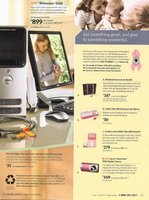



High-Dollar Cause-Related Marketing Comes of Age
Cause-related marketing has long been especially common in packaged goods promotions; Wish-Bone Dressing and Make-A-Wish or Yoplait and Susan G. Komen, to name just two. But does cause-related marketing work with high-dollar goods and services? More and more the answer is yes.
Above are four recent campaigns… from Dell, Oreck, American Century Investments, and Levenger… that increasingly demonstrate that cause-related marketing has legs even when the items in play cost hundreds or dollars or more.
Let me hasten to add that none of these high-dollar cause-related marketing promotions are exactly ‘first-movers.’
Ford and BMW have both done cause-related marketing promotions.
Kitchen Aid has long made special editions of their appliances in pink that generate donations for Susan G. Komen. They’ve also done straightforward ‘buy a qualifying dishwasher and we’ll donate $50 to Susan G Komen’ promotions.
Whirlpool… which owns Kitchen Aid… donates a refrigerator and a range for each new Habitat for Humanity home, but does not tie a donation to a purchase. Instead they use country music star Reba McEntire to solicit donations for Habitat. (They have also sponsored Reba’s tours.)
In October 2005 in the wake of Hurricane Katrina Oreck, which has a factory in Long Beach, Mississippi, not only kept their factory going, but housed employees and their families on the factory’s grounds. At that time, Oreck promised to give a matching vacuum to a family affected by Katrina for every Oreck sold. It was a ‘ten-bagger,’ to appropriate legendary investor Peter Lynch’s term, because it got their employees back to work and it put vacuums in the hands of people cleaning up after the devastation. Nice!
None of the high-dollar campaigns illustrated are exactly peerless in the execution of their promotion. Dell’s campaign promises to donate a portion of the proceeds to Susan G. Komen. ‘Proceeds’ is a mighty slippery word. Likewise, American Century Investment’s language that investments in the branded funds ‘can’ help support the mission of LiveSTRONG is just a few steps this side of weaselly. Levenger’s effort for the George Eastman House doesn’t exactly warm the cockles of my heart. And, I can’t shake the suspicion that Oreck merely raised the price of their special-edition vacuum $50 to cover the $50 donation to Susan G. Komen for demo’ing their vacuum.
But add these campaigns to the recently-reviewed campaign for Montblanc watches and it’s becoming clear that marketers and nonprofits are using tactical cause-related marketing to bring heart and customers to their high-dollar products and services. This makes perfect sense since surveys in the States have long shown that higher-income people are those most responsive to cause-related marketing.
So to marketers of high-dollar goods and services I say, there’s no longer a need to just dip your toe in. Cause-related marketing is a proven marketing tactic for your audience. Jump right it, the water's fine!
Cause-related marketing has long been especially common in packaged goods promotions; Wish-Bone Dressing and Make-A-Wish or Yoplait and Susan G. Komen, to name just two. But does cause-related marketing work with high-dollar goods and services? More and more the answer is yes.
Above are four recent campaigns… from Dell, Oreck, American Century Investments, and Levenger… that increasingly demonstrate that cause-related marketing has legs even when the items in play cost hundreds or dollars or more.
Let me hasten to add that none of these high-dollar cause-related marketing promotions are exactly ‘first-movers.’
Ford and BMW have both done cause-related marketing promotions.
Kitchen Aid has long made special editions of their appliances in pink that generate donations for Susan G. Komen. They’ve also done straightforward ‘buy a qualifying dishwasher and we’ll donate $50 to Susan G Komen’ promotions.
Whirlpool… which owns Kitchen Aid… donates a refrigerator and a range for each new Habitat for Humanity home, but does not tie a donation to a purchase. Instead they use country music star Reba McEntire to solicit donations for Habitat. (They have also sponsored Reba’s tours.)
In October 2005 in the wake of Hurricane Katrina Oreck, which has a factory in Long Beach, Mississippi, not only kept their factory going, but housed employees and their families on the factory’s grounds. At that time, Oreck promised to give a matching vacuum to a family affected by Katrina for every Oreck sold. It was a ‘ten-bagger,’ to appropriate legendary investor Peter Lynch’s term, because it got their employees back to work and it put vacuums in the hands of people cleaning up after the devastation. Nice!
None of the high-dollar campaigns illustrated are exactly peerless in the execution of their promotion. Dell’s campaign promises to donate a portion of the proceeds to Susan G. Komen. ‘Proceeds’ is a mighty slippery word. Likewise, American Century Investment’s language that investments in the branded funds ‘can’ help support the mission of LiveSTRONG is just a few steps this side of weaselly. Levenger’s effort for the George Eastman House doesn’t exactly warm the cockles of my heart. And, I can’t shake the suspicion that Oreck merely raised the price of their special-edition vacuum $50 to cover the $50 donation to Susan G. Komen for demo’ing their vacuum.
But add these campaigns to the recently-reviewed campaign for Montblanc watches and it’s becoming clear that marketers and nonprofits are using tactical cause-related marketing to bring heart and customers to their high-dollar products and services. This makes perfect sense since surveys in the States have long shown that higher-income people are those most responsive to cause-related marketing.
So to marketers of high-dollar goods and services I say, there’s no longer a need to just dip your toe in. Cause-related marketing is a proven marketing tactic for your audience. Jump right it, the water's fine!
Comments